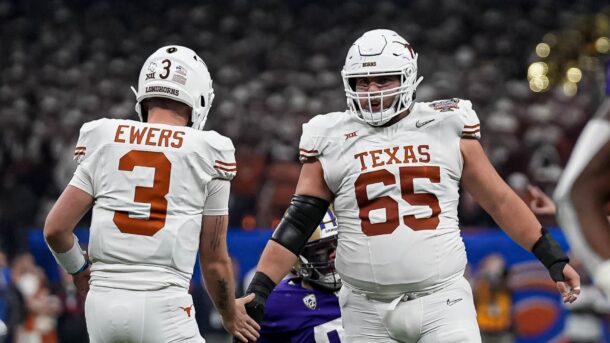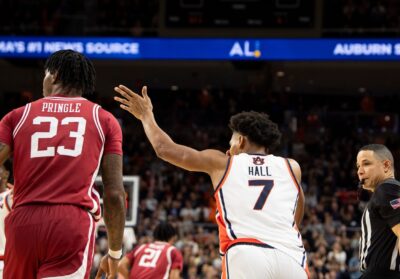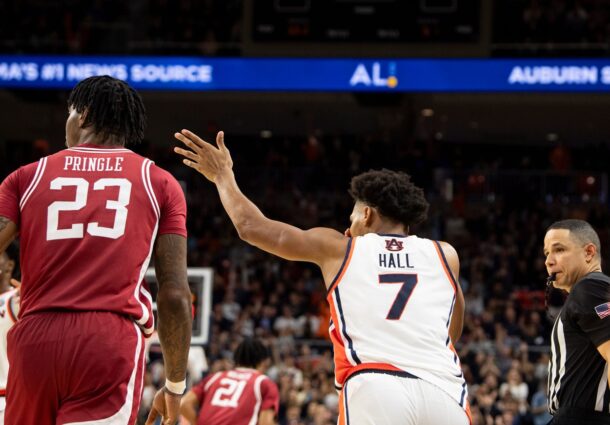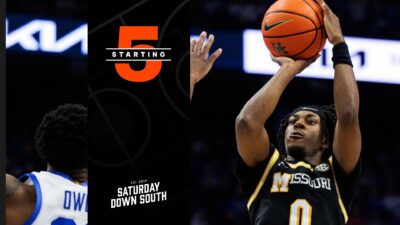
First and 10: There’s still 1 big thing college football needs to borrow from the NFL
By Matt Hayes
Published:
1. I don’t want to get on a soapbox, but …
We have to stop looking at what was, and start focusing on what is.
It took almost 150 years, but university presidents have finally come around — by force, by threat or by inevitability — to the reality that college football is a player’s game.
It’s about the players, not the universities.
I still vividly remember Bob Stoops sitting in his office before the 2008 season and pointing to Owen Field on the campus of Oklahoma, and telling me “that’s what makes the magic.”
He was talking, in context, about how the college game was unique because players and stars came and went, and the university was always there.
“I told Sam (Bradford) you know who wore No. 14 before you? Josh Heupel. He was pretty good, won a national title and was a Heisman (Trophy) finalist,” Stoops said. “And when you leave, there’ll be another 14 one day, maybe better than all of ’em. They’ll all have one thing in common — the Oklahoma across the front of the jersey.”
Smart team building, no doubt. But also forgetting one undeniable fact: Elite players make championship teams.
Or in this case, 16 years later, the players are the game. Just like the NFL.
I know that’s difficult for many hardcore college football fans to hear (and accept), but if we’re going to navigate these strange and sometimes surreal waters of change, that ideal — not some Pollyanna “amateur model” of years past — has to be the North Star.
This is a living, breathing, billion-dollar business.
When the SEC and Big Ten begin their newly reshuffled board with 16 and 18 teams, respectively, they’ll each earn nearly $1 billion annually in media rights. Add to that the $1.3 billion annually for the expanded Playoff — and the $800 million annually in media rights for the Big 12 and ACC combined — and you’re looking at the Power 4 conferences clearing more than $4 billion annually.
The NBA earns $2.7 billion annually in TV money. MLB is at $1.76 billion. The NFL will reach more than $12 billion in 2024.
And before the argument turns to teams and games and content, understand that the Big Ten and SEC (with 34 combined teams) could go it alone — and still earn nearly $3 billion annually in media rights on just football games.
“The other stuff — basketball, baseball and softball — is good content. But it’s a (offseason) placeholder,” an industry source told Saturday Down South. “Football drives everything.”
This, of course, leads us to the North Star of college football change: We must start thinking in terms of player movement and retention. It’s everything.
Because that, more than anything, will allow the process to proceed with as few hiccups as possible.
2. Thinking differently
The biggest misnomer of current college football change: NIL is killing the game.
Coaches don’t care that players make money on their name, image and likeness. It’s a headache, but it’s not a problem.
The problem for coaches and administrators is player movement, and how to prevent a player you’ve signed from high school and developed over the course of a career, from walking away at any time, for any reason.
Without consequence.
That’s where NIL enters the picture because of its ability to entice players to leave a team. NIL is the fuel, but the engine is free player movement — one free transfer during a career, or unlimited as a graduate transfer.
Roster management has always been the lifeblood of the sport. You recruit players, you develop, you wins games and maybe win a championship.
Movement and retention were never part of the equation until now. Understand this: There’s only one way to control player movement.
“Shared revenue,” an SEC athletic director told SDS. “We all know it. But how do we get there with a system that’s fair and equitable for everyone? That’s the real Project X.”
Getting there likely means players becoming employees, and collectively bargaining for a share of media rights. It may not be identical to the NFL, but every big move that has happened — from conference contraction (not expansion), to Playoff expansion — has had an eerie NFL flavor.
Even the latest news in Playoff expansion, where the tournament could move from 12 teams to 14 with the new contract in 2026. Guess who else has 14 teams in their playoffs?
The SEC and Big Ten didn’t magically decide one day that, for the good of all mankind, they would play nice together to forge a path for everyone else. This is — using NCAA Tournament lingo — survive and advance.
At the end of these discussions between the Power 2 (because that’s what the SEC and Big Ten are), there will be a roadmap to forward movement within the structure of college sports in general, and football specifically.
This is where we are headed, who wants in?
It will include shared revenue. It will include internal rules enforcement. Hell, it may include their own commissioner (hello, Nick).
Here’s what it won’t include: free player movement.
3. Moving forward, The Epilogue
So how does it all work? That’s what the new partnership between the SEC and Big Ten is all about.
In a perfect world, shared revenue includes collective bargaining, which leads to both sides winning. Players want revenue, universities want control and continuity. Not unlike the NFL.
Since the inception of NIL and free player movement in 2021, we’ve heard about the need for “guardrails” to define a seemingly uncontrollable situation.
This led to the narrative from coaches and administrators that NIL/free player movement was “unsustainable” — which, of course, is laughable. NIL is more impactful than ever, and the Playoff just signed a $1.3 billion annual media rights deal with ESPN.
Michigan doesn’t win the 2023 national title without NIL/free player movement strengthening its offensive and defensive lines from the transfer portal. Washington doesn’t get to the national championship game without it, nor does TCU in 2022.
If your point is it’s unsustainable for those not in the elite fraternity of Power conferences, the response is simple: When was it ever? The Group of 5/non-BCS teams were given BCS bowl games and New Year’s 6 games (and even a Playoff spot for Cincinnati) to prevent litigation.
That all ended with NIL and free player movement, and the United States Supreme Court not so subtly voting 9-0 and declaring players were allowed to receive “education-related benefits.”
What will the new world look like? Pay-for-play — with contracts. Unbreakable, collectively bargained contracts. Just like You Know Who.
Remember, it’s all about player movement and retention.
And return on investment.
4. Kalen DeBoer’s track record
If Alabama is going to survive the transition from the greatest coach in college football history to Kalen DeBoer, it’s going to be because of DeBoer’s track record of developing quarterbacks.
Beyond his work as an NCAA lower divisions star and successful FBS assistant, look at DeBoer’s quarterbacks at his 2 previous FBS head coaching jobs at Fresno State and Washington.
He arrived at Fresno State in 2020, and got Washington transfer to throw for career highs in yards (311) and TDs (3) in Week 2 of the COVID-shortened season. A year later, Heaner threw for 4,096 yards and 33 TDs and the Bulldogs won 9 games.
DeBoer took the Washington job in 2022, and reunited with Michael Penix Jr., whom he recruited and coached for a year at Indiana. Penix was a mess when he arrived in Seattle, dealing with multiple significant injuries and a 2021 season that finished with 4 TDs and 7 INTs.
In his first game against a Power 5 team in 2022, Penix had 397 yards and 4 TDs in a win over Michigan State, and threw for 9,544 yards and 67 TDs in 2 seasons with DeBoer.
The game is all about the quarterback, and Alabama has a raw but talented star in Jalen Milroe. If Milroe develops quickly like Haener and Penix, the idea of a step back for Alabama will end quickly.
Here’s a better way to look at it: Alabama went from Tommy Rees coaching quarterbacks and coordinating an offense, to DeBoer and Nick Sheridan (who has been with DeBoer at multiple stops (Indiana, Washington) developing Milroe.
5. The Weekly 5
The 5 best transfer portal additions for 2024.
1. DT Walter Nolen, Ole Miss. A violent, disruptive interior presence, and something Ole Miss has lacked under coach Lane Kiffin.
2. RB Trevor Etienne, Georgia. He’ll get more than 14 touches a game, and he’ll use the game-breaking speed to change the UGA backfield and offense.
3. DE Nic Scourton, Texas A&M: An active edge rusher who got lost in Purdue’s coaching transition. He’ll be a star in Mike Elko’s defense.
4. WR Isaiah Bond, Texas: Nick Saban has raved about Bond’s potential since 2022. Watch him put it all together in 2024.
5. OT Cayden Green, Missouri: Stick him at left tackle, and watch him grow into an NFL first round pick by 2025.
6. Your tape is your resume
An NFL scout analyzes a draft-eligible SEC player. This week: LSU WR Brian Thomas Jr.
“I’ve heard other (scouts) talk about the 1-year wonder thing. But (Thomas) got there, and they weren’t throwing the ball well at all. Then Brian Kelly gets there, and (Jayden) Daniels arrives, and it takes a while before they figure it out. I love this kid. He’s long and he’s all of 6-4, and he’s twitchy. Separation speed and great ball skills. Is he a guy that can work the middle? Not sure yet, but you stick him outside, and he’s going to win. He’ll get off the line, he’s explosive and has that rare catch radius.”
7. Powered Up
This week’s Power Poll ranks the 2024 nonconference schedules, toughest to easiest.
1. Florida: Miami, Samford, UCF, at Florida State. Florida AD Scott Stricklin has been at the forefront of Power 5 schools upgrading non-con schedules, and this one — combined with the brutal SEC schedule — is the toughest in college football in decades.
2. LSU: USC (Las Vegas), Nicholls, UCLA, South Alabama. USC and UCLA aren’t what they used to be but still are significant tests. South Alabama will be among the elite of the Group of 5 in 2023.
3. Georgia: Clemson (Atlanta), Tennessee Tech, UMass, Georgia Tech. Dawgs are paying $2.45 million for rent-a-win games against UMass ($1.9 million) and Tennessee Tech ($450,000).
4. Texas: Colorado State, at Michigan, UTSA, UL-Monroe. Longhorns get a gutted Michigan team (18 players at this week’s NFL Combine) in Week 2.
5. Texas A&M: Notre Dame, McNeese, Bowling Green, New Mexico State. A season-opener against Notre Dame for new Aggies coach Mike Elko, a former Irish DC (2017). The Notre Dame QB: Riley Leonard, Elko’s quarterback at Duke (2022-23).
6. Alabama: WKU, USF, at Wisconsin, Mercer. We’ll get an idea of DeBoer’s impact in Week 3, a tough game in what could be a wild night environment at Camp Randall Stadium.
7. Tennessee: Chattanooga, NC State (Charlotte), Kent State, UTEP. NC State is a de facto road game against a defense that was 25th in the nation in scoring in 2023 — and returns 14 players in their 4th or 5th season of college football.
8. Arkansas: Arkansas-Pine Bluff (Little Rock), at Oklahoma State, UAB, Louisiana Tech. We can do the mental gymnastics of Arkansas reaching 6 wins with a loss at Oklahoma State. The bigger question: Can Hogs start winning 1-possession games?
9. Oklahoma: Temple, Houston, Tulane, Maine. An anomaly. Don’t expect this type of non-con schedule from Oklahoma, which has upcoming home-and-homes with Michigan, Nebraska and Clemson.
10. Ole Miss: Furman, Middle Tennessee, at Wake Forest, Georgia Southern. Nothing new to see here. Ole Miss finally gets serious in non-con games in 2025-26, with a series against USC.
11. Kentucky: Southern Miss, Ohio, Murray State, Louisville. Mark Stoops is 34-6 in regular season non-con games at UK — with schedules that look a lot like 2024 — and 39-59 in all other games (SEC/bowl).
12. Auburn: Alabama A&M, Cal, New Mexico, UL-Monroe. Look at the bright side: Auburn can’t possibly lose a home game to another team from New Mexico, can it?
13. South Carolina: ODU, Akron, Wofford, at Clemson. How difficult in South Carolina’s SEC schedule? The Gamecocks may need to sweep the non-con for bowl eligibility.
14. Vanderbilt: Virginia Tech, Alcorn State, at Georgia State, Ball State. Every Vandy season begins and ends with non-con success. Get 4 wins, and bowl eligibility is within sight.
15. Mississippi State: Eastern Kentucky, at Arizona State, Toledo, UMass. The transition season: new coach, significant losses in the portal, and a winnable non-conference schedule.
16. Missouri: Murray State, Buffalo, Boston College, at UMass. Cake non-con schedule, and maybe the easiest SEC schedule — with the Tigers’ best team since 2007.
8. Ask and you shall receive
Matt: I have a feeling there are teams about to get exposed in the new SEC. Am I wrong? — George Denning, North Carolina.
George:
Adding Texas and Oklahoma alone changes the dynamics of the conference, but the elimination of divisions — and the annual opponents — will be a significant problem for a group of schools.
Exhibit A: Florida.
The Gators go from annual games against Vanderbilt, South Carolina, Missouri and Kentucky — all games on program strength and structure alone, the Gators should win — to just Kentucky in 2024. Florida still has games against heavyweight rivals from the old divisional setup (Georgia, Tennessee; LSU as West rival), and added Texas, Texas A&M, Ole Miss and Mississippi State.
South Carolina adds LSU, Ole Miss, Alabama and Oklahoma.
Mississippi State adds Florida, Texas, Georgia, Tennessee and Missouri.
Arkansas adds Tennessee and Texas, and only drops Alabama from its former divisional schedule.
There’s an argument to be made that Texas begins its first season with among the easiest of league schedules: Mississippi State, Oklahoma (Dallas), Georgia, at Vanderbilt, Florida, at Arkansas, Kentucky, at Texas A&M.
It’s certainly an easier road than Oklahoma: Tennessee, at Auburn, Texas (Dallas), South Carolina, at Ole Miss, at Missouri, Alabama, at LSU.
Once the SEC decides on 8 or 9 conference games, we’ll get a better understanding of the schedule rotation. Best guess: Like all things in college football moving more toward a pro model, the schedule will, too.
There will eventually be a set rotation that allows all teams to play everyone in the conference over a 4-year period, with home and away games against each opponent.
9. Numbers
8. Texas is the hot team in college football. Texas is a legit national championship contender, and a favorite to win the SEC in its first season in the league.
Texas also has 1 wide receiver returning who caught a pass in 2023, and Johntay Cook II had 8 catches. Backup TE Gunnar Helm and his 19 career catches also return, but QB Quinn Ewers will work with a completely new setup.
While there’s talent — WRs Isaiah Bond (Alabama), Silas Bolden (Oregon State), Matthew Golden (Houston) and 5-star freshman Ryan Wingo, and TE Amari Niblack (Alabama) — there’s a glaring lack of chemistry. Want to watch something this spring?
Watch the developing awareness between Ewers and his new receivers, and if it looks smooth by the end of 15 spring practices.
10. Quote to note
Texas A&M coach Mike Elko: “Where we sit now, we feel really good about where this roster is. We were able to go out and add a lot of value. We feel as though we have a team that can now go to work to become what we believe we are capable of becoming.”
Matt Hayes is a national college football writer for Saturday Down South. You can hear him daily from 12-3 p.m. on 1010XL in Jacksonville. Follow on Twitter @MattHayesCFB






